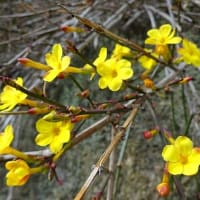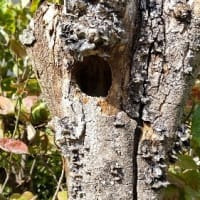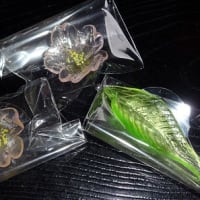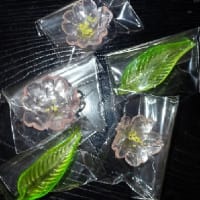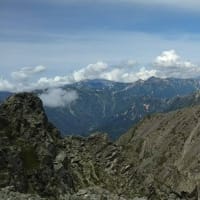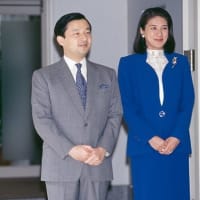「太平洋と時間を超える折り鶴」 「折り鶴に託す物語」より
広島の日に向け、折り鶴の少女・佐々木禎子さんと「原爆の子の像」設立に関する本や オバマ前大統領の広島での演説を読み返し、敬宮様が卒業文集で書かれた「世界の平和を願って」の素晴らしさに改めて感動している。
敬宮様の作文を拝見する直前、私は広島を訪れていた。
鉄骨が剥き出しになった原爆ドームや平和記念資料館の数々の展示物は、原爆の威力の凄まじさと原爆症の悲惨さを、まっすぐに強烈に私達に伝えてくる。
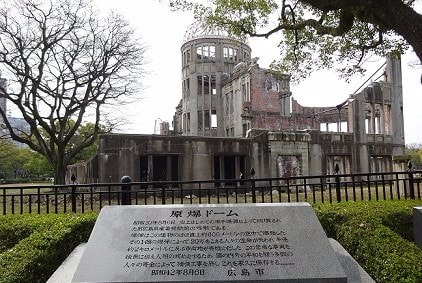
まさか平和祈念式典の平和宣言で原爆投下の日を間違えるとか、唯一の被爆国でありながら傘を押し戴く政治とかほど情けなくはないが、目にするもの全てが あまりに悲惨なので、あの日の私は怒りと悲しみで思考停止にはなってしまった。
だが、情けなく臆病な大人に対して、子供代表の「平和への誓い」は心をうつ。
思えば、原爆病で亡くなった禎子さんの無念と平和を祈る思いを継いで、折り鶴を掲げ持つ「原爆の子の像」の設立に動いたのは、まだ中学生でしかない禎子さんの同級生たちだった。
原爆投下で壊滅状態に陥った広島に 投下後たった三日で路面電車を走らせたのは、女学生だった。
この事実に敬宮様は心打たれたとニュースで伝えていたが、敬宮様の作文を読み返しながら、あの日から今日までの広島の子ども達を思うと、若者というものは、どんな悲惨な状況でも それを(とりあえず)受け留め、目の前にある自分達に出来る事に懸命に取り組むという’’力’’があるのだろうかと、今更ながら勇気づけられる思いがしている。
敬宮様や広島の子ども達は、戦争と原爆の恐ろしさと悲惨さの前に打ちのめされるだけでなく、その先の未来に希望を見出し、又そのためにすべき行動を考え、情けなく臆病な大人が云えない正しい未来を、まっすぐに語りかけてくる。
<「世界の平和を願って」=愛子さまの卒業文集公表―宮内庁> 時事通信 3/22(水) 11:05配信
宮内庁は22日、皇太子ご夫妻の長女愛子さま(15)が学習院女子中等科を卒業されるのに合わせ、愛子さまが卒業記念文集に寄せた作文を公表した。
「世界の平和を願って」との題で、昨年5月の修学旅行で広島市を訪れた際に感じたことや、平和への思いがつづられている。全文は次の通り(表記は原文通り)。
世界の平和を願って 敬宮 愛子
卒業をひかえた冬の朝、急ぎ足で学校の門をくぐり、ふと空を見上げた。雲一つない澄み渡った空がそこにあった。家族に見守られ、毎日学校で学べること、友達が待っていてくれること…なんて幸せなのだろう。なんて平和なのだろう。青い空を見て、そんなことを心の中でつぶやいた。このように私の意識が大きく変わったのは、 中三の五月に修学旅行で広島を訪れてからである。
原爆ドームを目の前にした私は、突然足が動かなくなった。まるで、七十一年前の八月六日、その日その場に自分がいるように思えた。ドーム型の鉄骨と外壁の一部だけが今も残っている原爆ドーム。写真で見たことはあったが、ここまで悲惨な状態であることに衝撃を受けた。平和記念資料館には、焼け焦げた姿で亡くなっている子供が抱えていたお弁当箱、熱線や放射能による人体への被害、後遺症など様々な展示があった。これが実際に起きたことなのか、と私は目を疑った。平常心で見ることはできなかった。そして、何よりも、原爆が何十万人という人の命を奪ったことに、怒りと悲しみを覚えた。命が助かっても、家族を失い、支えてくれる人 も失い、生きていく希望も失い、人々はどのような気持ちで毎日を過ごしていたのだろうか。私には想像もつかなかった。
最初に七十一年前の八月六日に自分がいるように思えたのは、被害にあった人々の苦しみ、無念さが伝わってきたからに違いない。これは、本当に原爆が落ちた場所を実際に見なければ感じることのできない貴重な体験であった。
その二週間後、アメリカのオバマ大統領も広島を訪問され、「共に、平和を広め、核兵器のない世界を追求する勇気を持とう」と説いた。オバマ大統領は、自らの手で折った二羽の折り鶴に、その思いを込めて、平和記念資料館にそっと置いていかれたそうだ。私たちも皆で折ってつなげた千羽鶴を手向けた。私たちの千羽鶴の他、この地を訪れた多 くの人々が捧げた千羽鶴、世界中から届けられた千羽鶴、沢山の折り鶴を見たときに、皆の思いは一つであることに改めて気づかされた。
平和記念公園の中で、ずっと燃え続けている「平和の灯」。これには、核兵器が地球上から姿を消す日まで燃やし続けようという願いが込められている。この灯は、平和のシンボルとして様々な行事で採火されている。原爆死没者慰霊碑の前に立ったとき、平和の灯の向こうに原爆ドームが見えた。間近で見た悲惨な原爆ドームとは違って、皆の深い願いや思いがアーチの中に包まれ、原爆ドームが守られているように思われた。「平和とは何か」ということを考える原点がここにあった。
平和を願わない人はいない。だから、私たちは度々「平和」「平和」と口 に出して言う。しかし、世界の平和の実現は容易ではない。今でも世界の各地で紛争に苦しむ人々が大勢いる。では、どうやって平和を実現したらよいのだろうか。
何気なく見た青い空。しかし、空が青いのは当たり前ではない。毎日不自由なく生活ができること、争いごとなく安心して暮らせることも、当たり前だと思ってはいけない。なぜなら、戦時中の人々は、それが当たり前にできなかったのだから。日常の生活の一つひとつ、他の人からの親切一つひとつに感謝し、他の人を思いやるところから「平和」は始まるのではないだろうか。
そして、唯一の被爆国に生まれた私たち日本人は、自分の目で見て、感じたことを世界に広く発信していく必要があると思う。「平和」は、人任せにするの ではなく、一人ひとりの思いや責任ある行動で築きあげていくものだから。
「平和」についてさらに考えを深めたいときには、また広島を訪れたい。きっと答えの手がかりが何か見つかるだろう。そして、いつか、そう遠くない将来に、核兵器のない世の中が実現し、広島の「平和の灯」の灯が消されることを心から願っている。
弱冠15歳の少女が、ノーベル平和賞を受賞した世界の最高指導者の演説に、見事に応えておられる。
オバマ前大統領がその演説のなかで繰り返し「なぜ広島を訪れるのか」「広島で何を感じ、何を考えなければならないのか」「平和な世界の実現に不可欠で根源的な理念である天賦の人権の獲得は、人任せにするのではなく、世代をこえ伝え実現に努めねばならない物語だ」と語っている、その思いに、弱冠15歳の敬宮様の作文は見事に応えておられる。
そしてそれは、命の平等と尊重を見つめ続けている広島の子ども達も同じなのだと、思う。
私が広島を訪問した日も、原爆死没者慰霊碑の前には、日本人だけでなく一見して外国人だと分かる多くの人が、祈りを捧げるために静かに列をなしていた。
敬宮様は、原爆死没者慰霊碑の向こうに平和の灯火と原爆ドームを御覧になった時、『間近で見た悲惨な原爆ドームとは違って、皆の深い願いや思いがアーチの中に包まれ、原爆ドームが守られているように思われ』そして、『「平和とは何か」ということを考える原点がここにあった。』と書かれている。
この感性に、悲惨な状況にただ打ちのめされるのではなく 希望を見出される''強さ'’を感じたのは、この作文を書かれた頃の敬宮様が置かれた状況が、あまりに過酷だったからだが、繰り言のようにそれを蒸し返すのは、今日という日には相応しくないかもしれないので控えることにする。
三日後には、長崎に祈りを捧げながら、もう一度「世界の平和を願って」を拝読したいと思っている。
<「世界の平和を願って」英訳
https://japan-forward.com/princess-aikos-yearbook-essay-praying-for-peace-in-the-world/ より>
On March 22, the Imperial Household Agency announced that Toshinomiya Aiko-sama, the daughter of Crown Prince Naruhito and Crown Princess Masako, had written an essay for Gakushuin Girls’ Junior High School memorial yearbook on the occasion of her graduation. Princess Aiko’s essay, titled “Praying for Peace in the World,” is reprinted below in full:
One winter morning not long before graduation, I was hurrying through the front gates of the school when I happened to glance up at the sky. It was a perfectly clear day―there was not a single cloud anywhere to be seen. I have my family to look after me. I am able to go to school every day to learn. I have friends who are waiting for me… “How happy I am! And how peaceful,” I thought quietly to myself as I looked up at the blue sky. I began to think very differently about just how happy and peaceful my world is after I visited Hiroshima in May, during my third year of junior high school.
As I gazed up at the ruined dome directly under which the atom bomb exploded, I suddenly found that I was unable to move. It was as though I was standing at that spot on August 6, 71 years ago. I had seen the dome in pictures before, or at least what is left of it: the iron framework and part of the outer wall. But I was shocked to see it in person. It is so wretchedly horrifying and real. In the Hiroshima Peace Memorial Museum I saw the charred remains of lunchboxes which children killed in the blast had been holding. I saw many other exhibits, too, about the damage that heat rays and radioactivity cause to the human body, and about the after-effects of the bombing. I couldn’t believe my own eyes―could this really have happened? I could not view it all and maintain my presence of mind. More than anything else, I felt anger and sadness at the hundreds of thousands of lives taken by the bomb. And what about those who survived? How did they get through each day having lost their families, the people who took care of them, and even the will to go on living? How did they feel? I could not even begin to imagine it.
It was only when I first felt myself somehow back there that August day seventy-one years before that I began to know something of the suffering, the deep regret experienced by those who were in Hiroshima when the bomb was dropped. This was an invaluable experience―something that it is impossible to understand unless one has actually gone to the scene where the bomb fell and exploded more than seventy years ago.
Two weeks after I went to Hiroshima, the American president, Barack Obama, also went to the site of the bombing. While there, he expressed his desire to work together for greater peace, and to have the courage to pursue a world without nuclear weapons. President Obama folded two origami cranes himself while praying for peace, quietly placing them in the Peace Memorial Museum. We also offered the thousand-crane strand that we had all folded together. But there were thousand-crane offerings from many others who had come to Hiroshima, and from all over the world. When I saw all of these thousands upon thousands of folded cranes, I felt, anew, that everyone is united in the same desire.
In the Peace Memorial Park in Hiroshima there is the Flame of Peace which has been burning continuously since 1964. This flame was lit with the hope that one day there would be no more nuclear weapons in the world, and it will go on burning until that day comes. As a symbol of peace, this flame has been used in a variety of ceremonies. As I stood before the Memorial Cenotaph, I could see the skeletal dome beyond the Flame of Peace. But the dome that had appeared unspeakably cruel when I saw it up close now looked different. It was protected by the arch-shaped cenotaph, beneath which nestled all of the profound hopes and prayers of people from around the world. It was at this precise moment that I first asked myself, “What is peace?”
There is no one who does not wish for peace. This is why we speak of it so often. However, to speak of peace is one thing, but to achieve it in the world is not so easy. There are millions around the world who even today suffer from conflicts and wars. How should we work to make peace a reality? What should we do?
広島の日に向け、折り鶴の少女・佐々木禎子さんと「原爆の子の像」設立に関する本や オバマ前大統領の広島での演説を読み返し、敬宮様が卒業文集で書かれた「世界の平和を願って」の素晴らしさに改めて感動している。
敬宮様の作文を拝見する直前、私は広島を訪れていた。
鉄骨が剥き出しになった原爆ドームや平和記念資料館の数々の展示物は、原爆の威力の凄まじさと原爆症の悲惨さを、まっすぐに強烈に私達に伝えてくる。

まさか平和祈念式典の平和宣言で原爆投下の日を間違えるとか、唯一の被爆国でありながら傘を押し戴く政治とかほど情けなくはないが、目にするもの全てが あまりに悲惨なので、あの日の私は怒りと悲しみで思考停止にはなってしまった。
だが、情けなく臆病な大人に対して、子供代表の「平和への誓い」は心をうつ。
思えば、原爆病で亡くなった禎子さんの無念と平和を祈る思いを継いで、折り鶴を掲げ持つ「原爆の子の像」の設立に動いたのは、まだ中学生でしかない禎子さんの同級生たちだった。
原爆投下で壊滅状態に陥った広島に 投下後たった三日で路面電車を走らせたのは、女学生だった。
この事実に敬宮様は心打たれたとニュースで伝えていたが、敬宮様の作文を読み返しながら、あの日から今日までの広島の子ども達を思うと、若者というものは、どんな悲惨な状況でも それを(とりあえず)受け留め、目の前にある自分達に出来る事に懸命に取り組むという’’力’’があるのだろうかと、今更ながら勇気づけられる思いがしている。
敬宮様や広島の子ども達は、戦争と原爆の恐ろしさと悲惨さの前に打ちのめされるだけでなく、その先の未来に希望を見出し、又そのためにすべき行動を考え、情けなく臆病な大人が云えない正しい未来を、まっすぐに語りかけてくる。
<「世界の平和を願って」=愛子さまの卒業文集公表―宮内庁> 時事通信 3/22(水) 11:05配信
宮内庁は22日、皇太子ご夫妻の長女愛子さま(15)が学習院女子中等科を卒業されるのに合わせ、愛子さまが卒業記念文集に寄せた作文を公表した。
「世界の平和を願って」との題で、昨年5月の修学旅行で広島市を訪れた際に感じたことや、平和への思いがつづられている。全文は次の通り(表記は原文通り)。
世界の平和を願って 敬宮 愛子
卒業をひかえた冬の朝、急ぎ足で学校の門をくぐり、ふと空を見上げた。雲一つない澄み渡った空がそこにあった。家族に見守られ、毎日学校で学べること、友達が待っていてくれること…なんて幸せなのだろう。なんて平和なのだろう。青い空を見て、そんなことを心の中でつぶやいた。このように私の意識が大きく変わったのは、 中三の五月に修学旅行で広島を訪れてからである。
原爆ドームを目の前にした私は、突然足が動かなくなった。まるで、七十一年前の八月六日、その日その場に自分がいるように思えた。ドーム型の鉄骨と外壁の一部だけが今も残っている原爆ドーム。写真で見たことはあったが、ここまで悲惨な状態であることに衝撃を受けた。平和記念資料館には、焼け焦げた姿で亡くなっている子供が抱えていたお弁当箱、熱線や放射能による人体への被害、後遺症など様々な展示があった。これが実際に起きたことなのか、と私は目を疑った。平常心で見ることはできなかった。そして、何よりも、原爆が何十万人という人の命を奪ったことに、怒りと悲しみを覚えた。命が助かっても、家族を失い、支えてくれる人 も失い、生きていく希望も失い、人々はどのような気持ちで毎日を過ごしていたのだろうか。私には想像もつかなかった。
最初に七十一年前の八月六日に自分がいるように思えたのは、被害にあった人々の苦しみ、無念さが伝わってきたからに違いない。これは、本当に原爆が落ちた場所を実際に見なければ感じることのできない貴重な体験であった。
その二週間後、アメリカのオバマ大統領も広島を訪問され、「共に、平和を広め、核兵器のない世界を追求する勇気を持とう」と説いた。オバマ大統領は、自らの手で折った二羽の折り鶴に、その思いを込めて、平和記念資料館にそっと置いていかれたそうだ。私たちも皆で折ってつなげた千羽鶴を手向けた。私たちの千羽鶴の他、この地を訪れた多 くの人々が捧げた千羽鶴、世界中から届けられた千羽鶴、沢山の折り鶴を見たときに、皆の思いは一つであることに改めて気づかされた。
平和記念公園の中で、ずっと燃え続けている「平和の灯」。これには、核兵器が地球上から姿を消す日まで燃やし続けようという願いが込められている。この灯は、平和のシンボルとして様々な行事で採火されている。原爆死没者慰霊碑の前に立ったとき、平和の灯の向こうに原爆ドームが見えた。間近で見た悲惨な原爆ドームとは違って、皆の深い願いや思いがアーチの中に包まれ、原爆ドームが守られているように思われた。「平和とは何か」ということを考える原点がここにあった。
平和を願わない人はいない。だから、私たちは度々「平和」「平和」と口 に出して言う。しかし、世界の平和の実現は容易ではない。今でも世界の各地で紛争に苦しむ人々が大勢いる。では、どうやって平和を実現したらよいのだろうか。
何気なく見た青い空。しかし、空が青いのは当たり前ではない。毎日不自由なく生活ができること、争いごとなく安心して暮らせることも、当たり前だと思ってはいけない。なぜなら、戦時中の人々は、それが当たり前にできなかったのだから。日常の生活の一つひとつ、他の人からの親切一つひとつに感謝し、他の人を思いやるところから「平和」は始まるのではないだろうか。
そして、唯一の被爆国に生まれた私たち日本人は、自分の目で見て、感じたことを世界に広く発信していく必要があると思う。「平和」は、人任せにするの ではなく、一人ひとりの思いや責任ある行動で築きあげていくものだから。
「平和」についてさらに考えを深めたいときには、また広島を訪れたい。きっと答えの手がかりが何か見つかるだろう。そして、いつか、そう遠くない将来に、核兵器のない世の中が実現し、広島の「平和の灯」の灯が消されることを心から願っている。
弱冠15歳の少女が、ノーベル平和賞を受賞した世界の最高指導者の演説に、見事に応えておられる。
オバマ前大統領がその演説のなかで繰り返し「なぜ広島を訪れるのか」「広島で何を感じ、何を考えなければならないのか」「平和な世界の実現に不可欠で根源的な理念である天賦の人権の獲得は、人任せにするのではなく、世代をこえ伝え実現に努めねばならない物語だ」と語っている、その思いに、弱冠15歳の敬宮様の作文は見事に応えておられる。
そしてそれは、命の平等と尊重を見つめ続けている広島の子ども達も同じなのだと、思う。

私が広島を訪問した日も、原爆死没者慰霊碑の前には、日本人だけでなく一見して外国人だと分かる多くの人が、祈りを捧げるために静かに列をなしていた。
敬宮様は、原爆死没者慰霊碑の向こうに平和の灯火と原爆ドームを御覧になった時、『間近で見た悲惨な原爆ドームとは違って、皆の深い願いや思いがアーチの中に包まれ、原爆ドームが守られているように思われ』そして、『「平和とは何か」ということを考える原点がここにあった。』と書かれている。
この感性に、悲惨な状況にただ打ちのめされるのではなく 希望を見出される''強さ'’を感じたのは、この作文を書かれた頃の敬宮様が置かれた状況が、あまりに過酷だったからだが、繰り言のようにそれを蒸し返すのは、今日という日には相応しくないかもしれないので控えることにする。
三日後には、長崎に祈りを捧げながら、もう一度「世界の平和を願って」を拝読したいと思っている。
<「世界の平和を願って」英訳
https://japan-forward.com/princess-aikos-yearbook-essay-praying-for-peace-in-the-world/ より>
On March 22, the Imperial Household Agency announced that Toshinomiya Aiko-sama, the daughter of Crown Prince Naruhito and Crown Princess Masako, had written an essay for Gakushuin Girls’ Junior High School memorial yearbook on the occasion of her graduation. Princess Aiko’s essay, titled “Praying for Peace in the World,” is reprinted below in full:
One winter morning not long before graduation, I was hurrying through the front gates of the school when I happened to glance up at the sky. It was a perfectly clear day―there was not a single cloud anywhere to be seen. I have my family to look after me. I am able to go to school every day to learn. I have friends who are waiting for me… “How happy I am! And how peaceful,” I thought quietly to myself as I looked up at the blue sky. I began to think very differently about just how happy and peaceful my world is after I visited Hiroshima in May, during my third year of junior high school.
As I gazed up at the ruined dome directly under which the atom bomb exploded, I suddenly found that I was unable to move. It was as though I was standing at that spot on August 6, 71 years ago. I had seen the dome in pictures before, or at least what is left of it: the iron framework and part of the outer wall. But I was shocked to see it in person. It is so wretchedly horrifying and real. In the Hiroshima Peace Memorial Museum I saw the charred remains of lunchboxes which children killed in the blast had been holding. I saw many other exhibits, too, about the damage that heat rays and radioactivity cause to the human body, and about the after-effects of the bombing. I couldn’t believe my own eyes―could this really have happened? I could not view it all and maintain my presence of mind. More than anything else, I felt anger and sadness at the hundreds of thousands of lives taken by the bomb. And what about those who survived? How did they get through each day having lost their families, the people who took care of them, and even the will to go on living? How did they feel? I could not even begin to imagine it.
It was only when I first felt myself somehow back there that August day seventy-one years before that I began to know something of the suffering, the deep regret experienced by those who were in Hiroshima when the bomb was dropped. This was an invaluable experience―something that it is impossible to understand unless one has actually gone to the scene where the bomb fell and exploded more than seventy years ago.
Two weeks after I went to Hiroshima, the American president, Barack Obama, also went to the site of the bombing. While there, he expressed his desire to work together for greater peace, and to have the courage to pursue a world without nuclear weapons. President Obama folded two origami cranes himself while praying for peace, quietly placing them in the Peace Memorial Museum. We also offered the thousand-crane strand that we had all folded together. But there were thousand-crane offerings from many others who had come to Hiroshima, and from all over the world. When I saw all of these thousands upon thousands of folded cranes, I felt, anew, that everyone is united in the same desire.
In the Peace Memorial Park in Hiroshima there is the Flame of Peace which has been burning continuously since 1964. This flame was lit with the hope that one day there would be no more nuclear weapons in the world, and it will go on burning until that day comes. As a symbol of peace, this flame has been used in a variety of ceremonies. As I stood before the Memorial Cenotaph, I could see the skeletal dome beyond the Flame of Peace. But the dome that had appeared unspeakably cruel when I saw it up close now looked different. It was protected by the arch-shaped cenotaph, beneath which nestled all of the profound hopes and prayers of people from around the world. It was at this precise moment that I first asked myself, “What is peace?”
There is no one who does not wish for peace. This is why we speak of it so often. However, to speak of peace is one thing, but to achieve it in the world is not so easy. There are millions around the world who even today suffer from conflicts and wars. How should we work to make peace a reality? What should we do?










